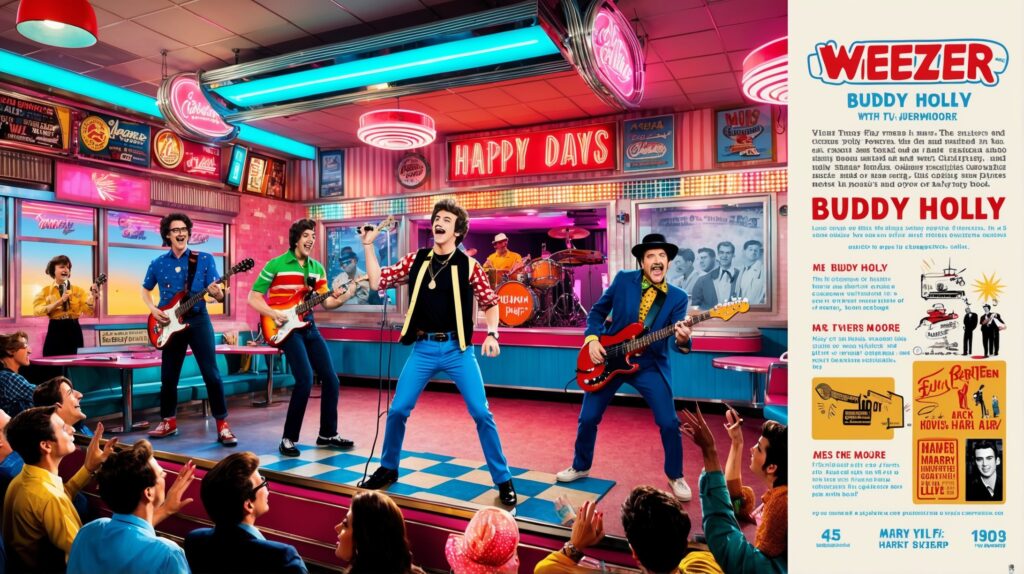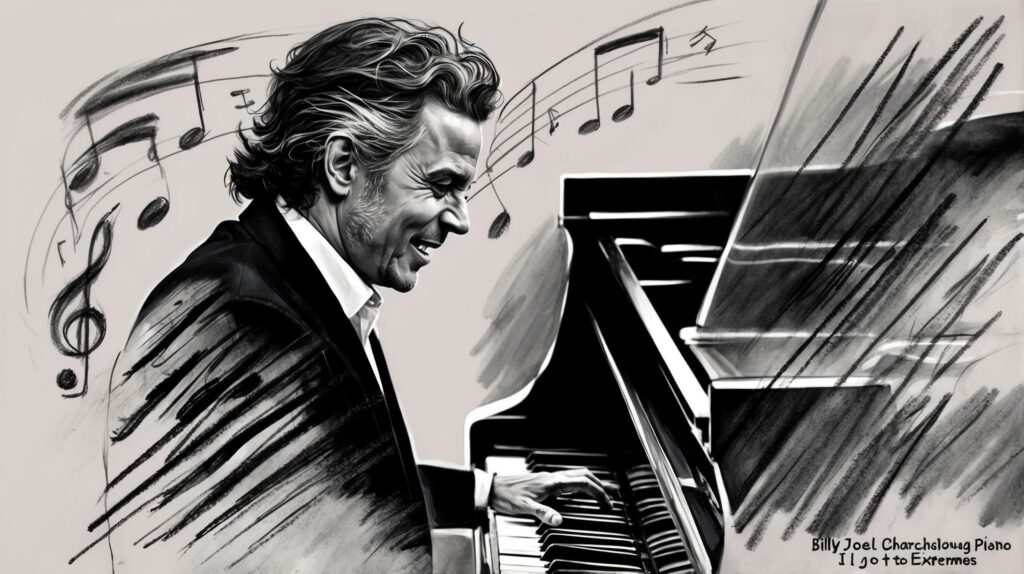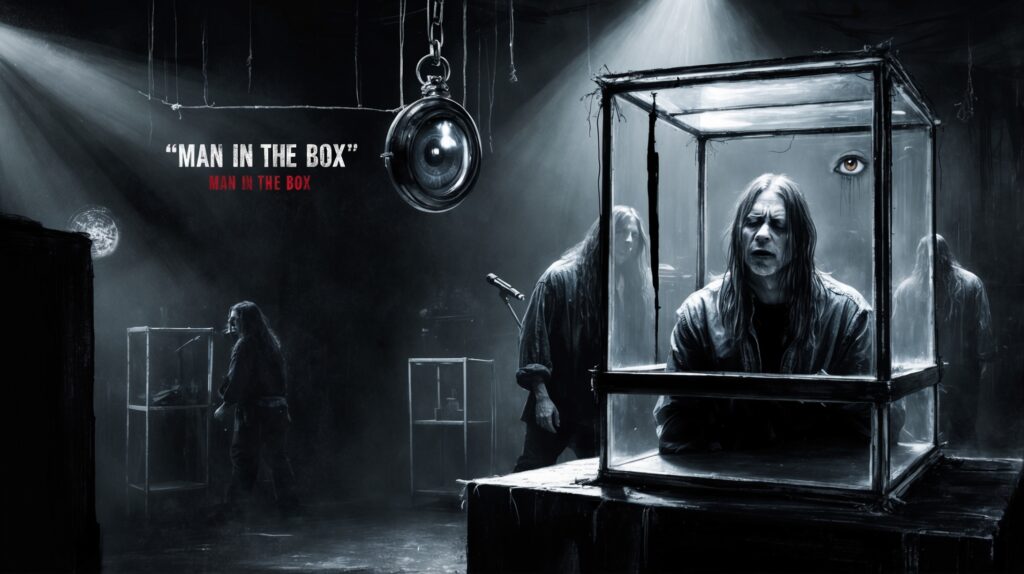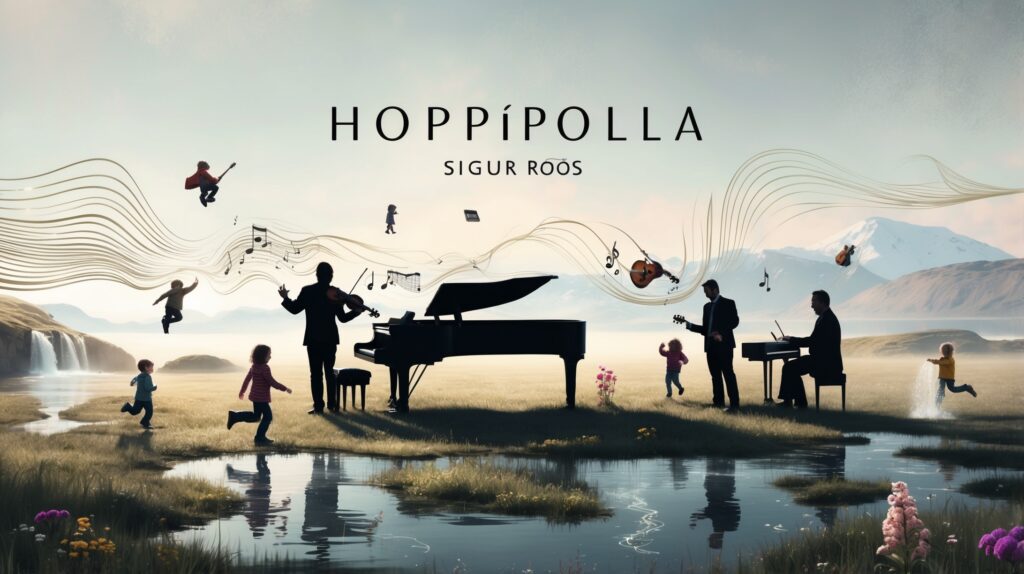The Energetic Evolution of Weezer: A Band That Defined an Era
Weezer, emerging in the early 90s with their unique sound, quickly became alt-rock icons. Their track “Buddy Holly,” released in 1994, played a pivotal role in defining their career, showcasing the band’s fusion of geeky charm and musical prowess.
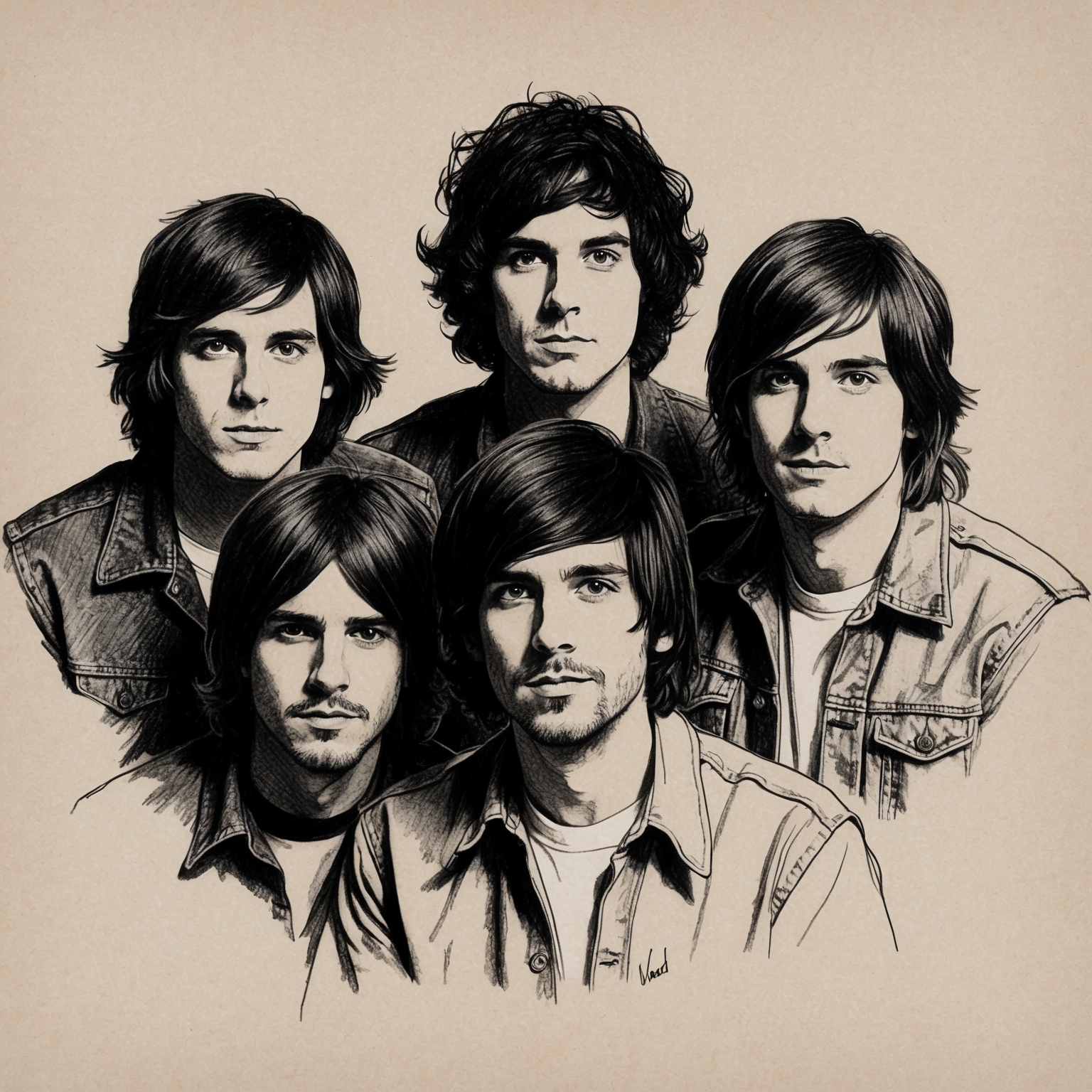
Weezer, a band synonymous with the 90s alternative rock explosion, marked a lasting impression in the music industry with their distinctive sound and quirky approach to songwriting. Formed in Los Angeles in 1992, Weezer quickly carved out a niche with their blend of power pop melodies and garage rock energy. Their self-titled debut album, often referred to as the Blue Album, was a breath of fresh air upon its release in 1994, featuring tracks such as “Buddy Holly,” which not only cemented their status as alt-rock staples but also showcased their knack for crafting unforgettable hooks.
The origins of Weezer trace back to the creative vision of lead vocalist and guitarist Rivers Cuomo. Born in New York and raised in Connecticut, Cuomo’s early life was characterized by a variety of musical influences, ranging from heavy metal to pop. This eclectic blend was honed during his time at the prestigious Berklee College of Music, where he forged the foundational skills that would later contribute to Weezer’s signature sound. The band’s formation represented the fusion of Cuomo’s artistic ambitions with the talents of drummer Patrick Wilson, bassist Matt Sharp, and guitarist Brian Bell (who joined after the recording of the Blue Album).
A noteworthy aspect of Weezer’s journey is their collaborative spirit, particularly evident during the creation of the Blue Album. Under the production of Ric Ocasek, known for his work with The Cars, the band found the perfect balance between raw, garage energy and polished pop sensibility. The era surrounding “Buddy Holly”‘s release was a dynamic time in music, with the grunge movement reigning supreme. Weezer’s bright, catchy tunes provided an antidote to the darker tones of the era, offering music that was both introspective and widely accessible. The song helped the band stand out in a saturated market, allowing them to capture the imagination of fans and critics alike.
Rivers Cuomo: The Creative Force Behind ‘Buddy Holly’
Explore Rivers Cuomo’s role as the composer of Weezer’s ‘Buddy Holly’, his musical influences, and how his unique style contributed to the song’s success.

Background and Career: Rivers Cuomo, the lead vocalist and guitarist of Weezer, is more than just a frontman; he is the genius composer behind many of the band’s iconic hits, including ‘Buddy Holly’. Born in New York City and later relocating to Connecticut, Cuomo’s early life sowed the seeds of musical intrigue as he experimented with various rock and metal influences. A Yale University graduate, Cuomo’s diverse educational background and formative experiences contributed significantly to his eclectic musical style.
Musical Style and Influences: Cuomo’s musical repertoire is best known for its blend of power pop, alternative rock, and a tinge of grunge, reminiscent of the early ’90s rock scene. He draws influences from bands like The Beach Boys and Nirvana, which can be seen in his catchy melodies and edgy lyrics. This fusion serves as a hallmark of Cuomo’s compositions, making them both widely accessible and critically acclaimed.
Role in the Song’s Creation: In ‘Buddy Holly’, Cuomo’s composition played a pivotal role in crafting the song’s upbeat yet nostalgic vibe. His knack for integrating clever hooks with engaging rhythms is evident in how the song effortlessly combines upbeat tempos with a deep sense of nostalgia. Cuomo’s unique musicality was crucial in bringing the song’s intriguing character to life and making it a memorable staple of ’90s rock.
Impact on the Song’s Success: The success of ‘Buddy Holly’ can largely be attributed to Cuomo’s masterful composition. Critics and fans alike have praised its infectious energy, underpinned by Cuomo’s signature style. The song’s prominent place in Weezer’s oeuvre is a testament to Cuomo’s ability to create music that resonates with a broad audience. His composition not only anchors the song’s success but also elevates Weezer as a defining band of their era.
Celebrating ‘Buddy Holly’: Accolades, Covers, and Pop Culture Impact
Weezer’s ‘Buddy Holly’ has amassed awards and captivated pop culture, with notable covers and media appearances sustaining its iconic status.

‘Buddy Holly’ by Weezer has not only achieved iconic status since its release but also garnered significant recognition within the music industry. One of the song’s biggest accolades came when the music video, directed by Spike Jonze, won several awards. It earned four honors at the 1995 MTV Video Music Awards, including Best Alternative Video and Breakthrough Video, highlighting the innovative visual storytelling that complemented the song’s quirky charm. The unique blend of ’50s nostalgia and 21st-century alt-rock flair has kept ‘Buddy Holly’ a perennial favorite. Over the years, ‘Buddy Holly’ has been featured in various forms of media, solidifying its place in pop culture. Notably, it was included in the video game ‘Rock Band’, allowing a new generation of music fans to play along to its infectious riffs. The song’s nostalgic yet energetic vibe has also made it a frequent choice for TV shows and movies, each usage further embedding the track in the cultural consciousness. The song’s recognition and popularity have inspired numerous covers over the years. Artists across diverse genres have interpreted ‘Buddy Holly’, breathing new life into it with their unique styles. Notable covers include renditions by The Countdown Singers and the punk rock band NFG, each providing a distinct twist on Weezer’s original creation. These covers testify to the song’s versatility and enduring appeal in the world of music. Collectively, the awards and accolades, along with its appearances in media and impact through covers, illustrate how ‘Buddy Holly’ continues to resonate across different platforms and audiences, maintaining its status as an essential track in the annals of rock history.
Chart Success: From Underdog to Iconic Track
“Buddy Holly” by Weezer, released in 1994, is a testament to the band’s growing popularity. Although it initially entered the charts quietly, the song became a standout due to its catchy rhythm and iconic music video, peaking at number 18 on the Billboard Modern Rock Tracks chart. It helped solidify Weezer’s place in the competitive alternative rock scene.
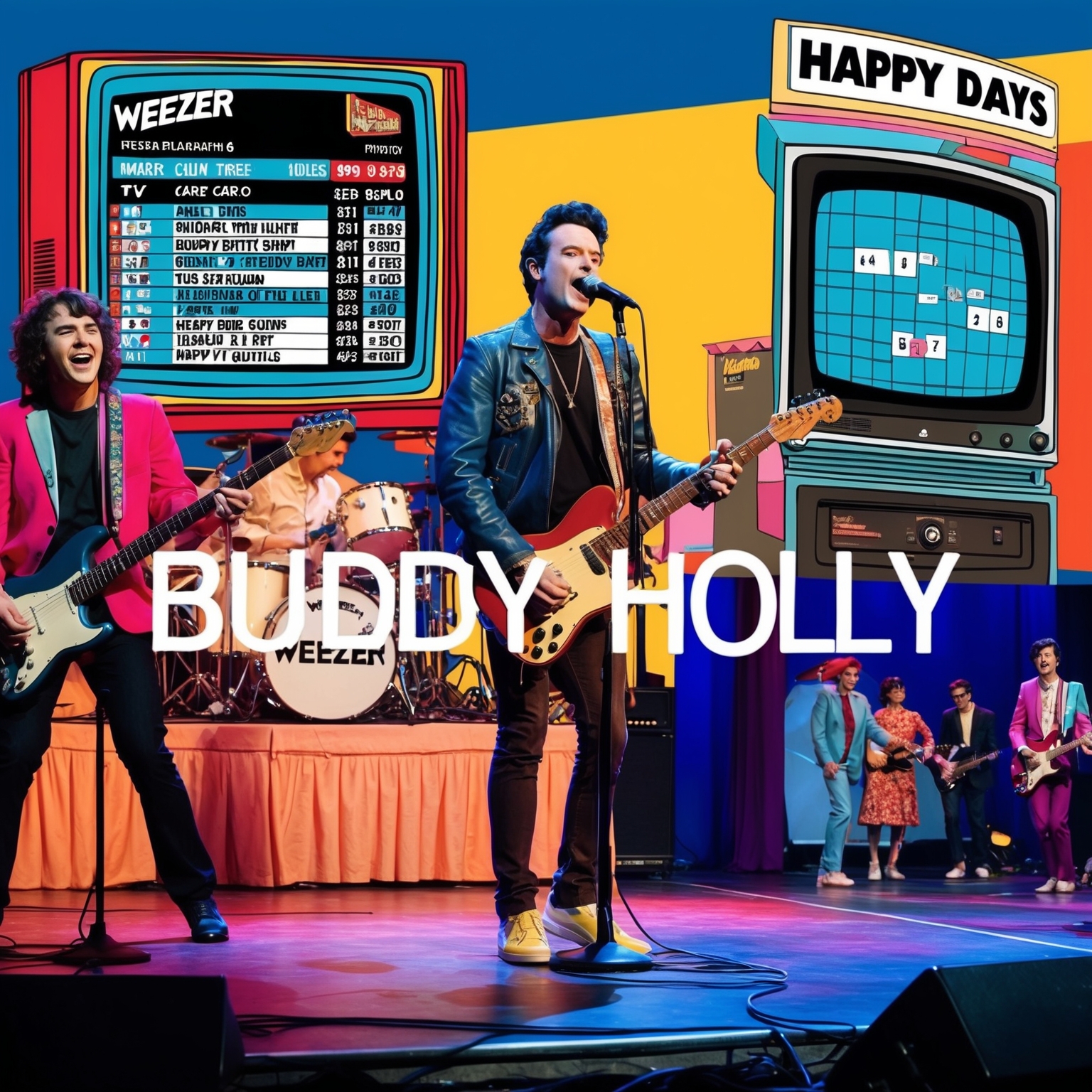
“Buddy Holly,” released by Weezer on September 7, 1994, as part of their debut album often referred to as “The Blue Album,” made an indelible mark on the music charts. Initially, the song made a quiet entry, but it quickly gained momentum, thanks to its catchy rhythm and compelling music video, which helped it soar to new heights. Although it never topped the charts instantly, its lasting presence and impact are undeniable. It peaked at number 18 on the Billboard Modern Rock Tracks chart, signaling Weezer’s growing popularity in the alternative rock scene.
The song emerged during a time when grunge and alternative rock were fiercely competitive, and despite the tough competition from powerhouse bands, “Buddy Holly” managed to carve out a space for itself. It stood out with its distinctive sound and quirky charm, setting Weezer apart from their contemporaries. For Weezer, “Buddy Holly” wasn’t just a hit; it was a statement—a breakthrough from their earlier, lesser-known work that helped redefine the band’s image and sound.
The marketing strategy for “Buddy Holly” played a crucial role in its chart success. Geffen Records, the label behind Weezer, expertly promoted the song through its innovative, now-classic music video directed by Spike Jonze, which depicted the band performing inside Arnold’s Drive-In from the beloved TV show “Happy Days.” This blend of nostalgia and modern rock resonated with audiences, capturing both critical acclaim and public adoration. The song’s relevance hasn’t waned over the decades; it continues to find new life on streaming platforms and social media, where its resonant themes and catchy hooks captivate new generations.
A Visual Celebration: The Iconic ‘Buddy Holly’ Music Video
The ‘Buddy Holly’ music video, set in the world of ‘Happy Days’ and directed by Spike Jonze, became a cultural phenomenon that amplified Weezer’s mainstream success.
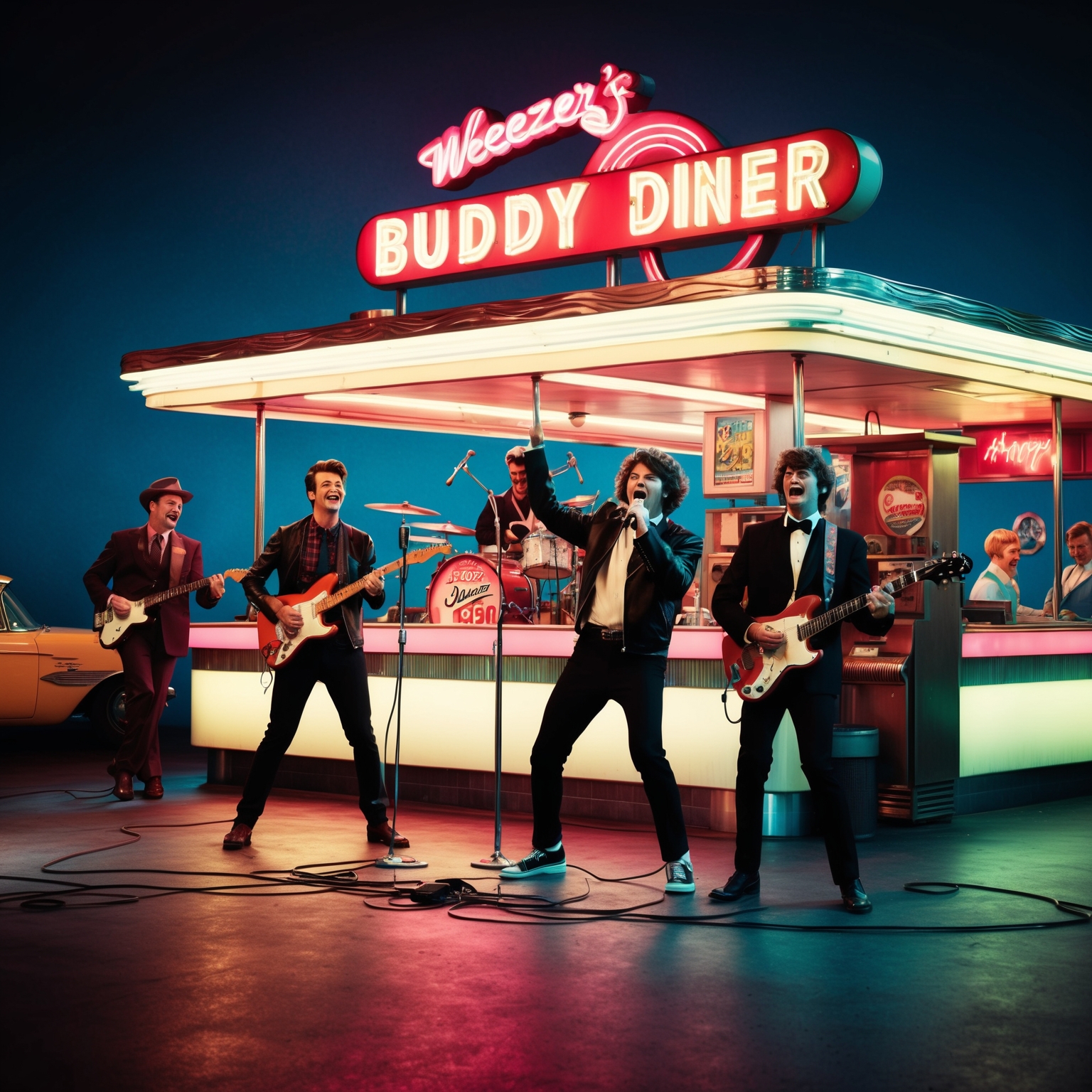
The music video for Weezer’s song “Buddy Holly” is a cultural artifact in its own right, and one that’s often credited with elevating the band’s popularity from niche alternative to mainstream rock prominence. Cleverly set in the fictional 1950s world of the iconic TV show Happy Days, the video features riveting visuals that mesh the nostalgic vibes of the past with the distinct musical style of the ’90s. Directed by the innovative filmmaker Spike Jonze, the music video recreates an episode in Arnold’s Drive-In, complete with numerous beloved characters like Richie, Potsie, and even the Fonz, making it both a tribute and a parody.
Spike Jonze’s direction is a standout feature of the music video, as he expertly blends real TV footage with new shots of the band performing, creating a seamless interaction between the two eras. This creative approach not only captured the song’s playful tone but also added a layer of visual storytelling, enhancing the already catchy sound with memorable imagery. The seamless editing and clever use of technology allowed Weezer to appear as though they were playing live in the 1950s diner setting while surrounded by characters and moments from a show that holds nostalgic significance for many.
The music video for “Buddy Holly” was both a critical and commercial success, attributing to the song’s lasting legacy as a pop culture staple. Not only did it receive extensive airplay on music channels like MTV, but it also garnered multiple awards, including several from the MTV Video Music Awards, where it won Best Alternative Video. The unique concept and flawless execution were lauded by critics and fans alike, cementing its place as one of the most iconic music videos of the 1990s. Furthermore, the involvement of Spike Jonze added an intriguing artistic layer that is often analyzed and appreciated in the world of music video production. The convergence of music, film, and television in this visual piece made it not just a promotional tool, but an essential part of the song’s storytelling and enduring appeal.
Unraveling the Musical Architecture of ‘Buddy Holly’
Buddy Holly’ is a masterful combination of power pop and alternative rock, marked by its catchy melodies and energetic rhythm, aligned with Weezer’s early signature sound.
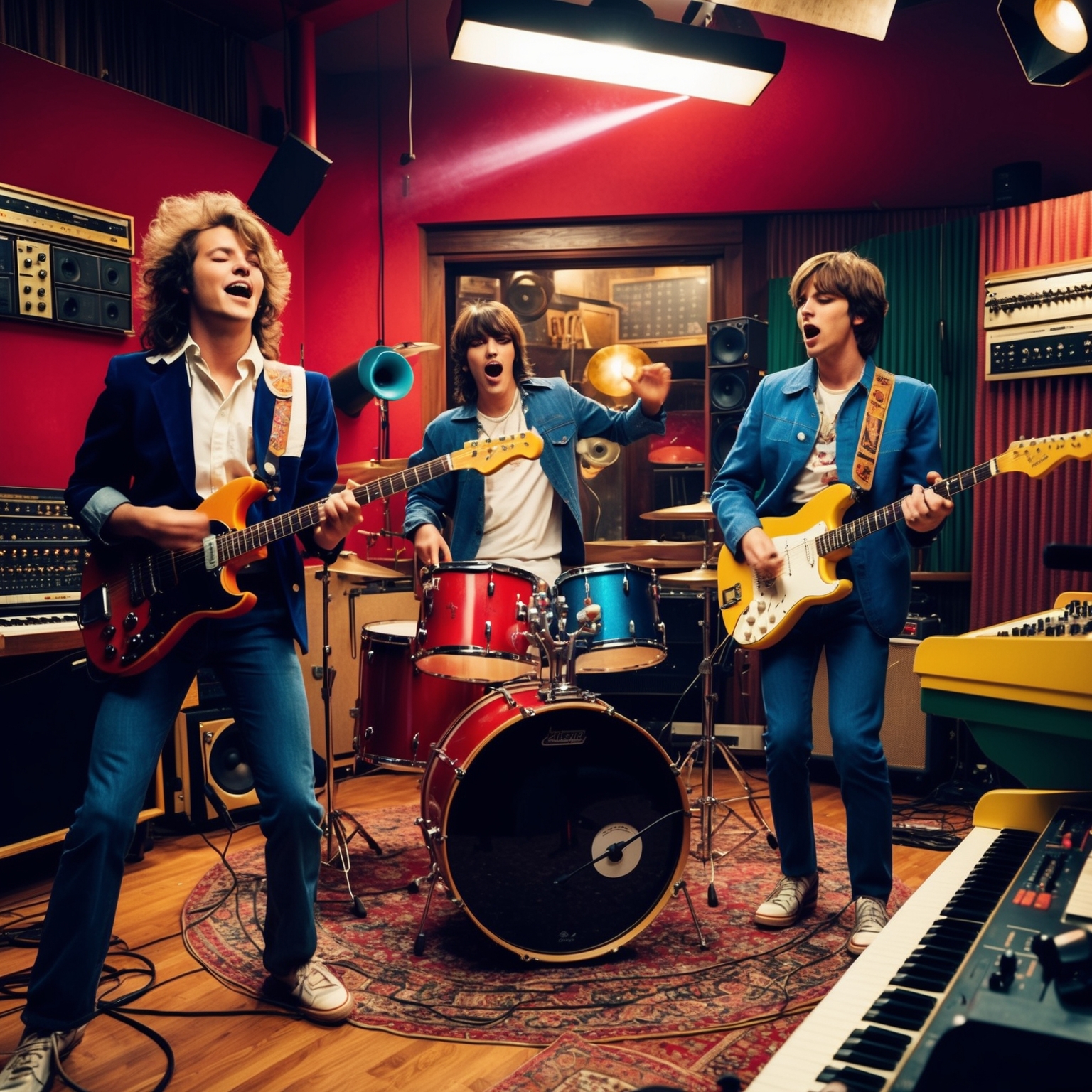
‘Buddy Holly’ by Weezer is an exemplar of smart and catchy songcraft, embodying a blend of power pop and alternative rock that would come to define much of the band’s early sound. This track, written in the key of B major, thrives on its punchy chord progressions and energetic tempo, set around 121 beats per minute. The simplicity of its verse-chorus form belies a clever construction that provides immediate memorability.
The song’s chord structure predominantly utilizes the I-IV-V progression but adds dynamics with unexpected shifts and syncopated rhythms. This gives the song a buoyant feel which, coupled with its brisk tempo, propels the listener through the track’s just over two-and-a-half-minute runtime. A notable aspect is the punchy, memorable guitar hooks, which blend perfectly with Rivers Cuomo’s distinct vocal lines, resting comfortably within the melodic contours that suit his range.
The instrumentation on ‘Buddy Holly’ is relatively straightforward yet effective. The use of electric guitars, bass, and drums generates a raw yet polished rock sound that is complemented by subtle touches of keyboards that occasionally hover beneath the surface. These elements, along with the sharp production techniques of Ric Ocasek, lend the song its unique sonic identity. Significantly, ‘Buddy Holly’ marks a pivotal moment in Weezer’s discography, representing their flair for meshing punk-infused rhythms with pop sensibility.
Compared to other tracks in Weezer’s self-titled debut, commonly referred to as ‘The Blue Album,’ ‘Buddy Holly’ stands out not only for its compelling melody but also for its balance of earnestness and whimsy. This song, along with others like ‘Undone – The Sweater Song’ and ‘Say It Ain’t So,’ helped lay the groundwork for the band’s future endeavors, where they would continue to explore complex emotional themes while maintaining an accessible sound.
Recorded at Electric Lady Studios with Ric Ocasek, the session was reportedly both rigorous and filled with creative experimentation. Within this famous studio known for its rich musical history, Weezer encapsulated a sonic imprint that would echo in their future works, marrying intricate layers with straightforward pop-rock sensibilities. An intriguing anecdote from the recording process is the band’s meticulous approach to layering the guitar parts, underlining their dedication to achieving a pristine yet impactful sound.
Exploring the Lyrical Depth of ‘Buddy Holly’
Delve into the rich lyrical themes of “Buddy Holly” by Weezer – a celebration of love, loyalty, and cultural nostalgia through its clever storytelling and iconic references.
Why do they gotta front?
What did we ever do to these guys
That made them so violent?
But you know I’m yours
And I know you’re mine
And that’s for all time
Oo-wee-hoo, I look just like Buddy Holly
Oh-oh, and you’re Mary Tyler Moore
I don’t care what they say about us anyway
I don’t care about that
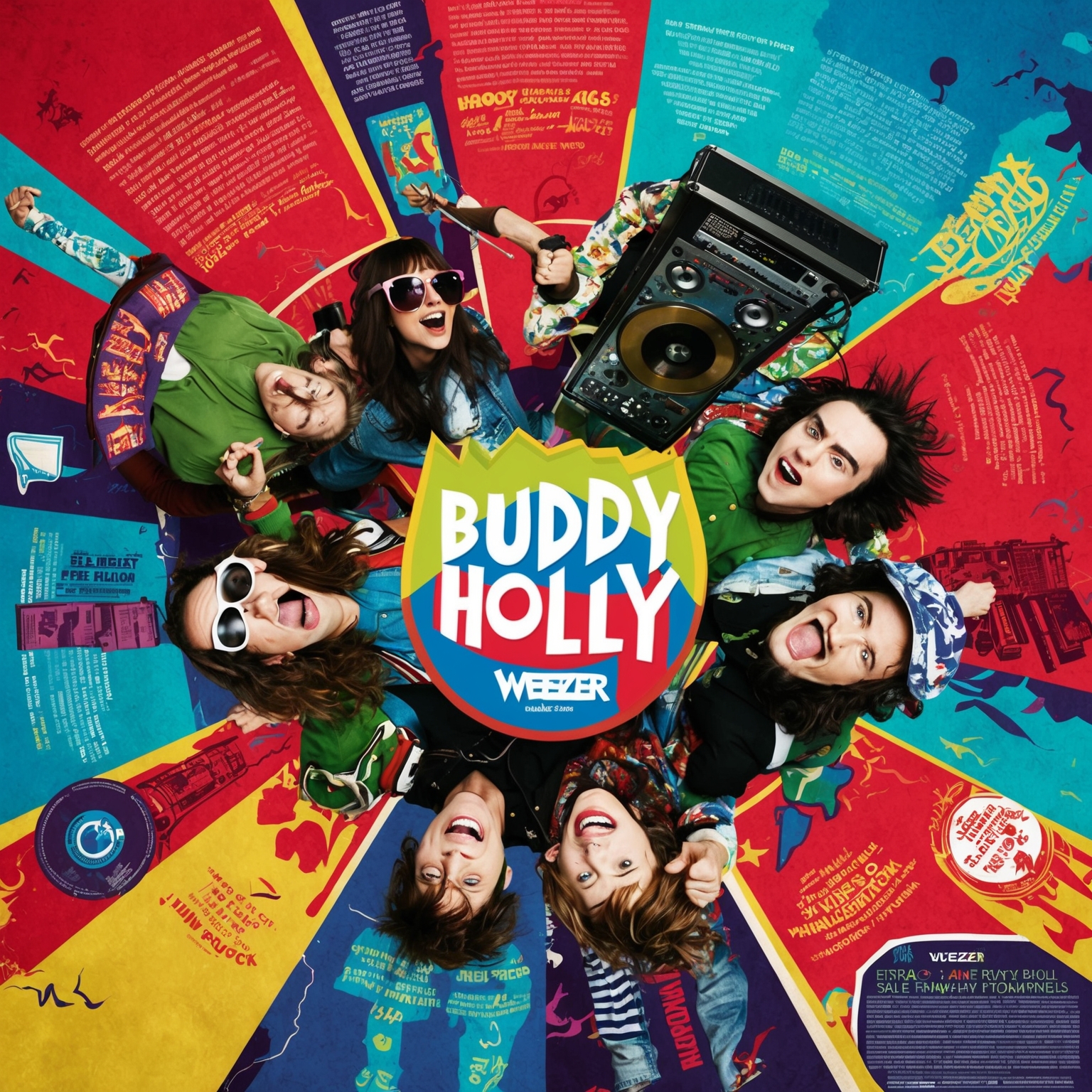 Weezer’s hit song “Buddy Holly” is a delightful blend of playful energy and lyrical depth. At first glance, its lyrics might seem simple, but a deeper look reveals a rich tapestry of themes and emotions. The song opens with questions that many listeners find relatable: **“What’s with these homies, dissing my girl?”** These lines immediately set a tone of youthful defiance and a quest for understanding, encapsulating the core sentiment of standing up for someone you care about amid external judgment.
Weezer’s hit song “Buddy Holly” is a delightful blend of playful energy and lyrical depth. At first glance, its lyrics might seem simple, but a deeper look reveals a rich tapestry of themes and emotions. The song opens with questions that many listeners find relatable: **“What’s with these homies, dissing my girl?”** These lines immediately set a tone of youthful defiance and a quest for understanding, encapsulating the core sentiment of standing up for someone you care about amid external judgment.
**Lyrical Themes and Messages**: The main themes in “Buddy Holly” revolve around loyalty, romantic devotion, and resilience against social pressures. The interplay between feeling wronged by ‘homies’ and the comfort of mutual love presents a duality that many individuals, especially in the transitional teenage years, may resonate with. This lyric encapsulates the timeless urge to shrug off societal criticism, a theme well-reflected during its 1994 release as grunge and alternative music questioned societal norms.
**Narrative and Storytelling**: The narrative unfolds through a conversational first-person perspective, allowing listeners to step into the shoes of someone grappling with peer disapproval yet finding solace in unwavering mutual affection. The storytelling is succinct yet evocative, with the lyrics drawing comparison to iconic TV figures such as Buddy Holly and Mary Tyler Moore, bridging generational gaps and evoking a sense of nostalgia. This technique enriches the narrative, transforming a personal story into a broader cultural commentary.
**Cultural and Social References**: The lyrical allusion to Buddy Holly and Mary Tyler Moore is a masterstroke, instantly evoking an image of classic American pop culture. Holly and Moore symbolize iconoclastic cool and endearing charm, respectively, adding depth and relatability for fans across different age demographics. This clever blend of music and visual media creates a rich tapestry that resonates with audiences beyond its original context, allowing each generation to find a unique entry point into the song’s world.
**Emotional Impact and Relatability**: The lyrics, underscored by catchy pop hooks, evoke a sense of defiant optimism. The line **“I don’t care what they say about us anyway”** becomes a rallying cry, embodying youthful rebellion balanced with personal confidence. This emotional core likely contributed to the song’s enduring popularity, as it offers an empowering message that transcends its immediate context to resonate with personal experiences of love, loyalty, and nonconformity across generations.
? Did you know? Weezer’s Buddy Holly video cleverly sets the band in an episode of ‘Happy Days’, making it a perfect blend of ’50s cool and ’90s rock! ? #Weezer #BuddyHolly #HappyDays #ThrowbackThursday tinyurl.com/y5njuj5s
Click to Tweet

